Ten years have passed since Fidel Castro announced that he would not accept re-election as Cuba’s president. How much money has been invested by the United States and Europe as they try to take advantage of this scenario? How many events have been held, how many publications have appeared in service of this objective? This is an attempted chronology – hastily assembled and surely incomplete – revisiting some of the events of the past decade, based on information freely available on the Internet.
2008
February 18: In a message from the Commander in Chief, Fidel announces to the Cuban people that he will not accept re-election as President of the Council of State and Commander in Chief: “To my dearest fellow Cubans, who recently granted me the enormous honor of my election to the Parliament, where important decisions about our Revolution’s destiny will be taken, I would like to inform you that I do not aspire nor will I accept – I repeat – do not aspire nor will I accept – the charge of President of the Council of State and Commander in Chief.”
February 21: The Spanish daily newspaper El País publishes an article by Antonio Caño containing an interview with “one of the foremost voices among Cuban exiles, the businessman Carlos Saladrigas,” who confides that Fidel Castro’s stepping down may be “the door that definitively opens toward change.” He asks the Cuban community in Miami and the US government to act “prudently” and with a “willingness to reconcile,” in order not to miss the opportunity. According to El País, Saladrigas “has spent millions from his personal fortune over the last few years to launch an embryonic moderate and centrist alternative among the elderly radical bosses who dominate the Cuban community in the United States.” The interview’s title includes a quote from the businessman: “Isolating the island will only extend the death throes of the regime.”
February 22: Fidel responds to Saladrigas in one of his “Reflections,” published by Granma, where the El País article from the previous day is reprinted in its entirety, and readers are invited to “enjoy” it while recalling the Saladrigas family ties with Fulgencio Batista: “How cheaply the new Carlos Saladrigas expects us to be purchased…with Miami’s money…the largest aid fund ever seen in history for any transition anywhere, something the United States has not been able to achieve with all the money in the world.”
May 8: El País grants its Ortega y Gasset Journalism Prize to Yoani Sánchez. Ernest Hernández Busto receives it in her name.
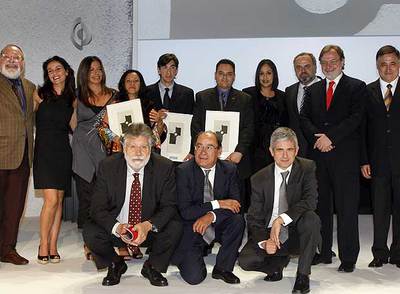
Back row, left to right: Fernando Savater, Blanca Marsillach, Angels Barcelo, Sanjuana Martínez, Ernesto Hernández Busto, César Rene Blanco, Adela Navarro, Ignacio Polanco, Juan Luis Cebrian, Gervasio Sánchez. Front row, left to right: Joaquin Estefania, Jesus Ceberio and Javier Moreno.
August 30: Ernesto Hernández Busto publishes the following at his Penultimas días (End days) blog: “My private personal opinion about the Cuban situation is that a US military intervention would be the fastest and most productive way of doing away with Castroism.”
2009
January 28: The blogging platform Voces Cubanas (Cuban Voices) is launched, with Yoani Sánchez at the helm.
April 15: The Chief of the U.S. Interests Section in Havana sends a cable to the State Department, disparaging the traditional methods of dissidence and opining that “Younger individuals, including bloggers, musicians, and performing and plastic [visual] artists do not belong to identifiable organizations, though they are much better at taking ‘rebellious’ stands with greater popular appeal.”
April 20: The USAID funded Zunzuneo platform is tested during the Concert for Peace in Havana.
September: U.S. Commerce Department’s Bureau of Industry and Security (BIS) issues a license exception that allows donated communication devices to be exported to Cuba, including “cellphones, SIM cards, PDAs, laptop and desktop computers, USB flash drives, Bluetooth equipment, and wireless routers.
December 4: Alan Gross, a U.S. “contractor” is captured in Cuba.
2010
February 21: Hillary Clinton states that the State Department is working “in more than 40 countries to help people silenced by oppressive governments.”
February: Zunzuneo is launched.
April 9: A conference on “cyberdissidence” is held under the auspices of the George W. Bush Institute in Texas. Ernesto Hernández Busto attends.
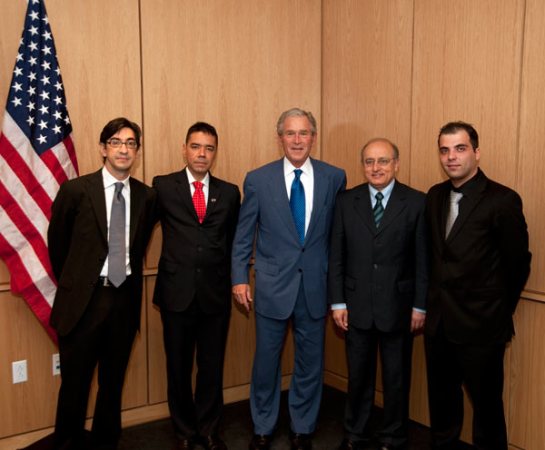
Ernesto Hernández Busto with George W. Bush and others. Ernesto is the one closest to the US flag.
November 20: The Latin American Personal Democracy Forum is held in Santiago de Chile, as part of Hillary Clinton’s “Civil Society 2.0” initiative. Ernesto Hernández Busto attends here as well. Alec Ross, Clinton’s senior advisor on innovation described the Internet as the “Che Guevara of the 21st Century.”

Alec Ross holding forth at a conference for Latin American bloggers and Twitter users, in Santiago de Chile, November 2010.
December 16: Leaked cables published by Wikileaks include one from April 15, 2009, damaging the internal legitimacy granted to Cuban blogger Yoani Sánchez. In the cable, the Chief of the U.S. Interests Section in Havana at the time, Jonathan Farrar wrote “We believe it is the younger generation of ‘non-traditional dissidents,’ such as Yoanny (sic) Sánchez, that is likely to have a greater long term impact on post-Castro Cuba.
2011
April 25-29: “Think Cuba,” a meeting organized by Stephanie Rudat, a State Department employee linked to regime change projects in Cuba and Europe, is held at Panama’s Miramar Intercontinental hotel.
May: As part of the US-Cuba Policy Initiative under the American Strategy Program at the New America Foundation, which also happens to be the largest beneficiary of USAID funds directed to “promoting democracy in Cuba, Arturo López Levy publishes “Change in Post-Fidel Cuba: Political Liberalization, Economic Reform and Lessons for U.S. Policy.” Regarding what he calls a “reform process,” “in tandem with political liberalization and the emergence of a Cuba more open toward the outside world,” López Levy tries to answer the question: “How do these trends relate to the strategic interests of American policy and its stated goal of promoting a peaceful transition to a market-oriented and democratic Cuba?”
July 1: First Twitthab event, directed toward Cuban Twitter users. BBC correspondent Fernando Ravsberg attends.
April 15-27: Ted Henken travels to Cuba on a tourist visa, writing at his El Yuma blog that he carried out more than forty interviews with a very diverse group of bloggers and micro-entrepreneurs. According to Enrique Ubieta, Henken’s polemics reveal him to have “behaved less as an accomplished academic, and more as an activist carrying out his assigned task.” In Henken’s account of his activities in Cuba, he says: “I spoke with two very hospitable grad-students from the University of Matanzas, Roberto González Peralo and Harold Cárdenas Lema, who co-founded and administrate (sic) the ‘revolutionary’ site (their words) La Joven Cuba, just as I spoke with Erasmo Calzadilla and Alfredo Fernández, a pair of very warm and sharp young bloggers who publish their critical observations of life in Cuba today at the site Havana Times. I did the same with the black feminist revolutionaries Sandra Álvarez and Yasmín Portales, both associated with the group Bloggers Cuba, as well as with the journalist Iván García and lawyer Laritza Diversent, both also black, who have been associated with the highly critical blogging portal Voces Cubanas. Finally, I met and exchanged ideas with the former biochemist, writer, and photographer Orland Luis Pardo Lazo and the researcher and long-time dissident Miriam Celaya, as well as with the techies and computer programmers ‘ZorphDark’ and RogerTM who have worked with the Bloggers Cuba digital collective.”
October 5: John Kerry, heading the US Senate’s Foreign Relations Committee, receives a report suggesting a “doctrine of effective connectivity,” for Latin America. Although Cuba is included, specific actions targeting this country are not divulged.
December 26: Ted Henken publishes his “preliminary map” of the Cuban blogosphere, in Spanish and English. Henken characterizes the bloggers he interviewed as people “building bridges” across the gap between “Cuban government propagandists” and “U.S. government mercenaries…[who are] fed up with the official governmental monologue.”
2012
February: Cuban American businessman Hugo Cancio founds the OnCuba magazine.
March 14: In Foreign Policy magazine’s supplement, The Cable, it is announced that Alec Ross is leaving the State Department. His work is revealed: “Ross also looked back proudly on the work his office did to help Syrian rebels restore communications and communicate securely after the revolution started and avoid persecution by the Assad regime. His shop provided communications technologies to opposition member in the Syrian border areas and trained NGOs on how to avoid the regime’s censorship and cyber snooping. State also worked during the Libyan uprising to restore communication networks in rebel-held territories such as Benghazi, working with the late Amb. Chris Stevens, to fight the Internet blackout imposed by Libyan leader Muammar al-Qaddafi…He trained dozens of U.S. ambassadors in understanding the impact of networks in foreign policy and taught classes for incoming Foreign Service officers at the Foreign Service Institute…Ross’s former office will continue to be housed inside the Office of the Secretary of State… ‘Instead of trying to create a new bureau, what we wanted to do was build a long-term institutional capacity. I leave feeling that the work has been fully institutionalized and that the programs will live on,’ Ross said.”

Alec Ross, right, with Conrad Tribble, left, just before Tribble headed to Cuba.
March 21: The Heritage Foundation, based in Washington DC, hosts an event, the premise of which is: “Cuba Needs a (Technological) Revolution. How the Internet Can Thaw an Island Frozen in Time.” The event is sponsored by Google Ideas and attended by its director, Jared Cohen, who Julian Assange once said “could be wryly named Google’s ‘director of regime change.’” Cuban American Senator Marco Rubio presides. Panelists include the Director of the US government funded Office of Cuba Broadcasting (Radio & TV Martí), Carlos García Perez, the businessman Carlos Saladrigas, James Glassman, vice-president of the George W. Bush Institute, and Mauricio Claver Carone, the head of the Cuba Political Action group. Claver Carone would go on to be the first Cuban American on the Trump team.

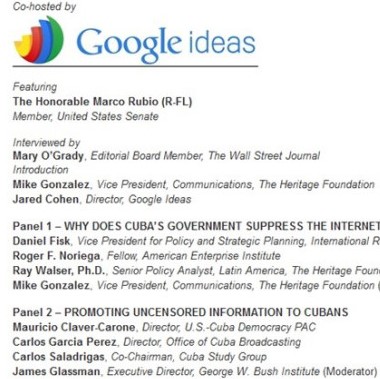
March 29: Carlos Saladrigas holds a conference in Havana, at the invitation of the editors at Espacio Laical (Secular Space) magazine. These editors would go on to found Cuba Posible, which they described as an “idea lab.” Saladrigas praises and has his picture taken with counter-revolutionaries linked to the U.S. Interests Section.
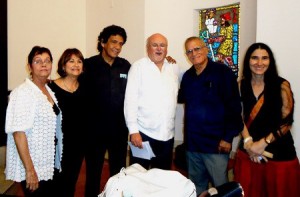
Carlos Saladrigas, at center, in white guayabera, with various and sundry counter-revolutionaries (Yoani Sánchez, his wife – far right – etc.). The group was gathered for a conference at the Centro Felix Varela, at the invitation of the editors at Espacio Laical, now the coordinators of Cuba Posible.
April 3: Fernando Ravsberg publishes an interview with Carlos Saladrigas, at the Spanish language site, BBC Mundo. “Dos días despues” (Two days afterwards) is repeatedly referenced at Saladrigas’s conference in Cuba, and is also extolled in Espacio Laical’s promotion of the event.
June: Espacio Laical creates Casa Cuba, the embryo for Cuba Posible.
June: Zunzuneo is shut down.
June: “Festival Clic” (Click Festival) is held at the Havana home of counter-revolutionary Antonio Rodiles, with support from the U.S. Interests Section. It is attended by Yoani Sánchez and Interests Section diplomats, and is underwritten by Evento Blog Espana, IBM, Microsoft, Jazztel and BBVA.

Announcement and invitation to Festival Clic, at Havana Times website.
July: Conrad Tribble arrives in Cuba as the Deputy Chief of the US Interests Section. He will eventually be promoted to Chief, where he will busy himself on social networks, searching for and interacting with Cuban Twitter users and bloggers.
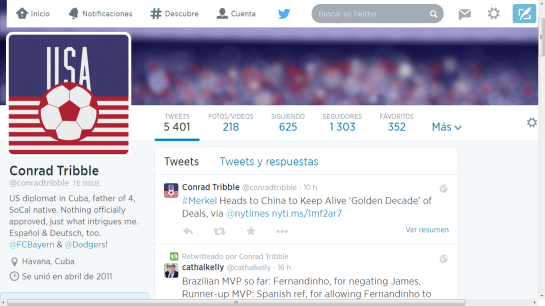 2013
2013
February 18: Yoani Sánchez begins her international tour in Brazil. Ted Henken will be her consigliere in the United States.
March 9: Cuban journalist resident in Miami, Edmundo García, states that Carlos Saladrigas is one of the mysterious promoters behind Yoani Sánchez’s US tour, and that he would be managing her White House introduction.
April: Piramideo, the Radio Martí project to send SMS messages and emails is launched, allowing Martínoticias.com to “connect with a million Cubans every month.”
April: Espacio Laical is denounced for using its Twitter account to promote the US government funded Diario de Cuba and Yoani Sánchez exclusively.

May 10: The second edition of Twitthab is held at Parque Villalón, attended by Fernando Ravsberg. Conrad Tribble, from the US Interests Section, also attends.
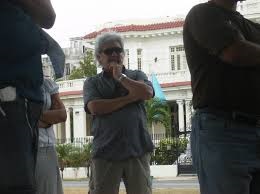
Fernando Ravsberg, glasses, center
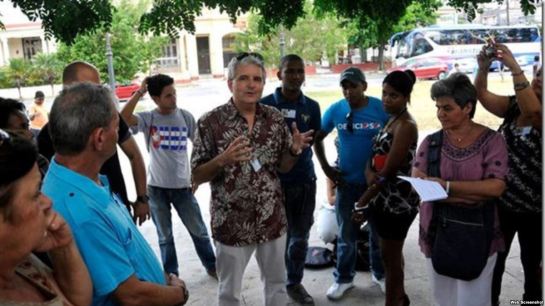
Conrad Tribble, tropical shirt, center, explaining…
May 14: El Toque, a platform belonging to Radio Nederland and financed by the Dutch government publishes its first article from Cuba, written by an anonymous author. The website’s stated objective is reporting from “countries where freedom of expression is limited, due to legislative impediments and taboos.” El Toque will initially publish young writers from Cuba, México, Venezuela and Colombia, but will end up publishing only Cubans.
2014
January 1: At the event marking the 55th anniversary of the Cuban Revolution, Raúl Castro denounces: “In our case, as in others around the world, attempts to subtly introduce platforms for neoliberal thought and the restoration of neocolonial capitalsm have been detected. They are based on a premeditated manipulation of history and the current situation of general crisis within the capitalist system, and directed at undermining values, national identity and culture, in favor of individualism, selfishness and mercantile interests above moral ones.”
March 6 & 7: The Espacio Laical magazine organizes the event “Religious faith, national institutions and social models,” with financing from the Norwegian government. Bloggers attending the event include those interviewed in 2011 by Ted Henken. In an interview with Progreso Semanal, one of the participants calls on the Cuban government to “moderate” its foreign policy in order to reach an understanding with the United States, while another calls for “shock treatment” in the Cuban economy.
April 12: Miguel Díaz Canel provides the closing keynote at the Eighth Congress of the Cuban Writers and Artists Union (UNEAC), held at Havana’s convention center. “The opportunism of those who are looking to distance themselves and become ‘celebrities’ by winking at the enemy, should be unmasked in our publications and on our social networks. We need to know how to differentiate between those who honestly present their doubts and criticisms in our spaces for debate, from those who are seeking fame, outside the country above all, through their opportunistic positions.”
May: BBC Mundo launches Voces desde Cuba (Voices from Cuba), with a mix of authors it refers to as “officialistas” (party-liners) and “dissidents.”
May 14: 14 y medio, Yoani Sánchez’s online newspaper is launched.
May 19: The Cuba Study Group, chaired by Carlos Saladrigas, sends an “Open Letter” to President Obama, signed by business tycoons, politicians, military officers and other “notable” figures, under the title: “Support Civil Society in Cuba.” Saladrigas tells the press: President Obama has repeatedly mentioned the inefficiency of US policy toward Cuba. It’s time to take the first steps to increase support for Cuban civil society.”
May: Elaine Díaz receives a scholarship from the Nieman Foundation at Harvard University. According to the foundation, she will study “internet-based journalism models that might serve multiple voices within Cuban civil society, with a particular focus on the building of political consensus and national reconciliation.”
June: Google’s president, Eric Schmidt, and Jared Cohen, director of Google Ideas, visit Cuba. They meet and speak twice with Yoani Sánchez. Schmidt is the president of the New America Foundation.
June: The Catholic church dismisses Lenier González and Roberto Veiga as editors of Espacio Laical.
July 4: Reuters interviews Roberto Veiga about his new project: Cuba Posible. “I have a personal opinion in favor of a multiparty Cuba. Our project wants to facilitate this and contribute to serenity in the process…Personally I support a Cuba with multiple political parties. Our project is meant to facilitate that and contribute to it happening through a peaceful process…Cuba Posible will promote ‘transitional change.’”
July 7: Elaine Díaz interviews Lenier González about Cuba Posible, in Global Voices.
“Cyberspace has been enormously helpful in creating positive synergies of understanding and de-polarization in Cuban society worldwide. If there is one thing that is typical of the past ten years, it has been a rush to ‘the center’ by an important combination of social and political actors, both on and off the island.” González suggests, “in the Cuban context this doesn’t mean modifying the ‘press model,’ rather, it means transforming the ‘State model.’ This ‘State model’ uses the constitution to consecrate an ideology, which it then projects over the entire nation, putting the entire institutional apparatus to work on its reproduction, as though it were a matter of a church and its faithful.”
September 9: It is announced that Yoani Sánchez has received a scholarship from Georgetown University.
October 22: At the plenary session of the Cuban Journalists Union (UPEC) the first National Media Survey is presented, showing evidence of a nascent private media system in Cuba, taking shape online.
November: Ernesto Londoño, editorial writer for The New York Times, visits Cuba. He meets with Yoani Sánchez and staffers at the Havana office of OnCuba during his visit.
November 21: The New York Times publishes a profile of Cuba Posible’s promoters. They are presented as two moderates who are “leading figures in an incipient culture of debate,” creating spaces to test “the Cuban appetite for finding a third way.”
November: Harold Cárdenas, from the La Joven Cuba website, tours the United States as the first Cuban invited by the US government’s Edward R. Murrow International Leadership Program. “The participants are emerging professionals in print and digital media, who come to the United States to study the rights and responsibilities of a free press in a democracy, by observing the operational practices, standards and institutions of the media.” In 2015 and 2016 he will be the sole Cuban invited to the “Atlantic Dialogues,” sponsored by the German Marshall fund, which according to its website “works to support transatlantic cooperation on regional, national and international challenges and opportunities, in the spirit of the Marshall Plan…by…contributing to research and analysis and gathering leaders on the transatlantic questions that concern policymakers…and…offering rising leaders opportunities to develop their abilities and networks through transatlantic exchange.” Other conference attendees include Kerry Buck, Canada’s ambassador to NATO, Katherine Almquist Knopf, the US Defense Department’s Director of Strategic Studies in Africa, and Michael Franken, Vice Admiral and adjutant for the US Military Command in Africa (AFRICOM).
December 17: A new US policy toward Cuba is announced.
December 19: Barack Obama explains the new US policy toward Cuba, at a press conference: “…this gives us an opportunity for a different outcome…it offers the prospect of telecommunications and the Internet being more widely available in Cuba in ways that it hasn’t been before. And over time, that chips away at this hermetically sealed society, and I believe offers the best prospect then of leading to greater freedom, greater self-determination on the part of the Cuban people. I think it will happen in fits and starts. But through engagement, we have a better chance of bringing about change than we would have otherwise.”
December 24: Tania Brugueras holds a performance at Havana’s Plaza de la Revolucion (Revolution Square) on December 30 that is blocked by Cuban authorities who denounce it as a political provocation. This marks the first large display on social networks of a political operation with Cuba as its target. The New York Times publishes an editorial stating: “Brugueras’s plan was the first test of whether the Obama administration’s decision to normalize relations with Cuba earlier this month would prod the Castro regime to be more tolerant of critical voices.”
December 26: Ernesto Londoño concludes his Cuba series published on the editorial page of The New York Times. The series opened on October 11 with a report about “The new and promising online voices in Cuba”: La Joven Cuba, La Chiringa de Cuba and the website 14 y medio.
2015
January 20: Cuba Posible publishes its first edition at its official website.
January 27 & 28: A Cuba Posible event is held in Washington DC with participation from the Cuba Research Center at Georgetown University. It is coordinated by Phil Peters, who Ted Henken claims is the person who introduced him to Yoani Sánchez. According to Progreso Semanal, Hugo Cancio (OnCuba) Harold Cárdenas (La Joven Cuba-El Toque), Elaine Díaz (Periodismo de Barrio) Norge Rodríguez Armiñán (Salir a la Manigua) and the directors and collaborators of Cuba Posible are all in attendance.
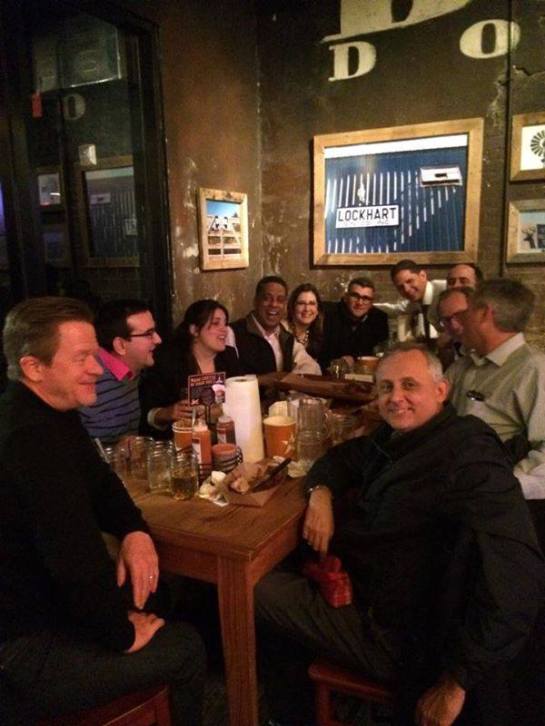
“Independent media” managers and collaborators, gathered in Washington DC. Foreground, left, Phil Peters, who Ted Henken says introduced him to Yoani Sánchez. To his left, Lenier González, Elaine Díaz, Hugo Cancio, Maria Isabel Ilfonso, unidentified man. Leaning over far end of table, in white shirt and tie: Harold Cárdenas. To Peters’ right, Roberto Veiga, followed by Arturo López Levy and two other unidentified men. Photo credit: Progreso Semanal
February 22: Reuters publishes a story about OnCuba’s owner: “Hugo Cancio: Cuba’s American business connection?” His financial history prior to doing business in Cuba is revealed: “His business struggled. The last time Fuego officially reported financial results it disclosed that in the nine months ended February 2009, its revenues were just $17,477, down 93 percent from the year-earlier period. It lost $113,917.
March: At his blog, Emilio Ichikawa, the Cuban philosopher/blogger residing in Miami, describes the official US position toward Cuba as “centrist”: “this is the position of the current Democratic administration in the United States, it is that of President Obama and his civil servants, including Secretary of State John Kerry and Roberta Jacobson. It is also the position of certain Cuban American intellectuals and Cuban moderates like Roberto Veiga, and that of high-profile intellectual (sic) businessmen such as Hugo Cancio.”
March 21: The Miami Herald’s Spanish language edition, El Nuevo Herald, publishes a proposal by Fundación Alternativas – linked to the Spanish Socialist Workers Party (PSOE in Spanish) – titled “Miami, Havana, Europe: a Roadmap” for Cuba: “The ‘third way’ that Europe and the United States should put on the negotiating table, the heart of the deal, does not necessarily involve huge demands for freedoms and political pluralism on the part of the Cuban regime – this could only come through the negotiation process anyway – but full access for nascent civil society. This means both those in ‘opposition’ as well as ‘non-opposition’ and those who have ‘not yet taken a position,’ whose economic foundations should be strengthened and support provided for travel, both inside and outside the country, while a middle class is progressively established.”
April: Fernando Ravsberg, now the editor of OnCuba – leads the questioning of the behavior of the Cuban civil society delegation at the Summit of the Americas in Panama: If Obama speaks with Raúl, why is ‘dissidence’ being denied a space? In June, Ravsberg abandons OnCuba, replaced by Progreso Semanal’s editor, Milena Recio.
May 19: Reuters interviews a senior State Department official about “democracy assistance programs in Cuba,” in light of Obama’s new approach toward the island: “The official, speaking on condition of anonymity, said the democracy programs ‘have changed over time, and they will continue to change over time to reflect a reality, whether that reality is on the ground in Cuba or in the United States.”
June 8: In a story for the Spanish daily Publico.es, Fernando Ravsberg calls Cuba Posible a “new political force;” a comment that is instantly picked up by the Radio and TV Martí websites.
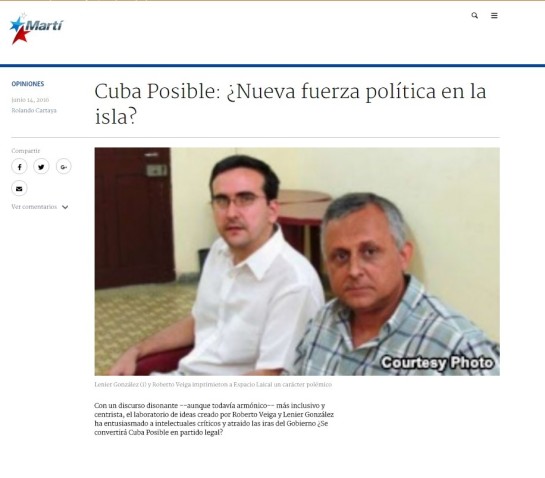
“Cuba Posible” promotion at website for US government funded Radio and TV Martí.
July: The Norwegian Embassy announces access to the Norwegian Fund, for Cuban cinema.
July: Elaine Díaz returns to Havana. She calls on Cuban journalists to come to work for the Periodismo de Barrio (Neighborhood Journalism) site, for 100 cuc per month. It is announced that the financing is to come from her fellowship savings, and donations.
July 27, 2015: Anthony Blinken, U.S. Assistant Secretary of State is interviewed by El País: “We believe that opening relations is the best way to accomplish the objectives held by those who supported the embargo. This will allow the Cuban people, the middle class, to have more contact with the world and with the United States. It will allow us to extend our contacts within Cuban society. The measures that we’re implementing will reinforce a Cuban middle class. This is the best instrument for achieving what we all want: a free, prosperous and democratic Cuba.
July: Ten young Cuban journalists travel to Berlin, to participate in a course financed by the Taz Panter Stiftung foundation, with support from the German Foreign Ministry and Reporters Without Borders. The meeting is organized by the director of Periodismo de Barrio. The course will be held annually.
October 1 & 2: The Norwegian Embassy in Cuba holds a seminar on “Internet and the Economy; Prospects and opportunities for the Cuban future.” Ted Henken attends, along with various bloggers. According to the Yoani$landia website, the event is organized by the bloggers Norge Rodríguez Armiñán and Taylor Torres, who receive $27,000 from the Embassy for the event.
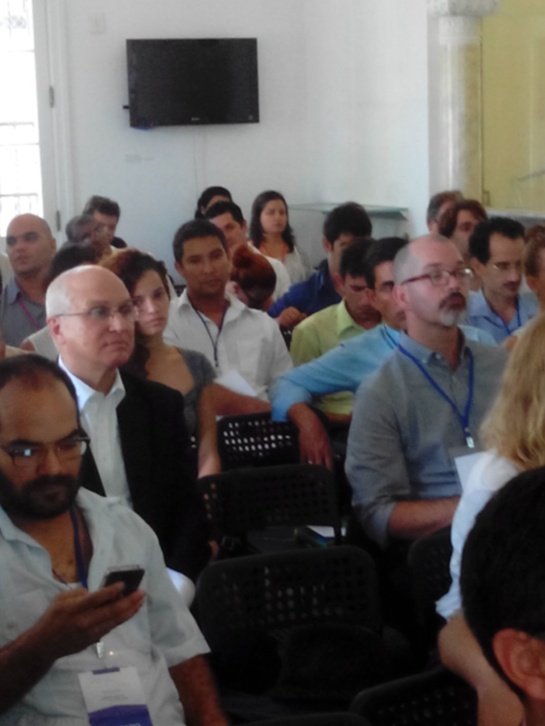
Ted Henken, right, front, in chambray shirt, with blue halyard and spectacles. At Norwegian embassy in Cuba.
October 4: TV Martí announces that it is searching for comedians to perform satire based on Cuban politicians and other public figures.
October 14: The Office of Cuba Broadcasting (Radio and TV Martí) delivers a prize for the creation of a network in Cuba to distribute DVDs and flash drives carrying Radio Martí content.
October 18: The first edition of Periodismo de Barrio is published.
2016
January: Radio Nederland’s El Toque dedicates itself exclusively to Cuban topics and Cuban writers. According to the publication, “El Toque Cuba’s new objective is to continue publishing the disquieting thoughts of young Cuban bloggers and journalists.” Harold Cárdenas is hired as its editor.
February: During a visit to the United States by Rodrigo Malmierca, Cuba’s Minister of Foreign Trade and Investment, the US Secretary of Commerce, Penny Pritzker, expresses “special interest in the changes that might be considered at Cuba’s next Party Congress.”
March 20-22: Barack Obama visits Cuba. At his speech at Havana’s Gran Teatro, directed at Cuba’s civil society , the U.S. Embassy invites a number of those present at the Cuba Posible event hosted in January 2015 at Georgetown University. Obama meets at the Embassy with “dissidents.” Both this year and the preceding one, official representatives from Europe, Canada and the United States who visit Cuba meet with those who were present at the January event in Washington DC.
March 27: Cuba Posible publishes an editorial: “The Last Battle for Cuba’s Future has Begun.”
April 13: Cuba Posible reports: “Four members from the Cuba Posible Ideas Lab completed an intense work program in Washington DC, organized by the US NGO, WOLA (Washington Office on Latin America). Ailynn Torres Santana (a member of the Board and coordinator of the “Fraternidad” (Brotherhood) program, Julio César Guanche (also a Board member and coordinator of the “Ágora” (Marketplace) program, Lenier González Mederos (Assistant Director), and Roberto Veiga González (Director) held a variety of meetings with distinguished representatives in Washington from the social, political and academic sectors.”
April 16: Once again, Raúl Castro denounces “the actions directed at introducing platforms for neoliberal thought and capitalist restoration, supported by a perverse strategy of political-ideological subversion that attacks the very essence of Cuba’s culture and its Revolution, its history and the values that were forged within it (…) These programs are directed toward the sectors that the enemy has identified as most vulnerable, concentrating on Cuba’s youth, its intellectuals, non-state workers and the communities with the greatest material and economic difficulties.”
April 16-19: The Seventh Congress of Cuba’s Communist Party is held. Foreign Minister Bruno Rodríguez calls Obama’s visit “an attack on our very foundation, our history, our culture and our symbols.”
May 2: Roberto Veiga, the director of Cuba Posible, acknowledges his “very cordial” relationship with Carlos Saladrigas.
May 26: An event titled “Cuba and its Current Challenges” is held at the headquarters of George Soros’s Open Society in New York, by invitation from Cuba Posible. Participants include ambassadors from Europe and the European Union in Cuba, as well as an “expert in transitions,” from the German Fiedrich Ebert Foundation.
July 12: According to the directors of Cuba Posible: “…we’ve worked and will continue to work with our foreign counterparts, one of which is George Soros’s Open Society Foundation.
August 22: In his letter to UNEAC on its anniversary, Raúl Castro notes: “Today we are under a double cultural threat: from subversive projects that are meant to divide us, and from the wave of global colonization.”
September 28: The Committee for the Protection of Journalists, Americas branch, issues a special report (in Spanish) for the Organization of American States (OAS) about Cuba, containing statements by bloggers and employees at new Cuban websites and digital magazines. Executive Summary in English here. Statements are also provided by those who attended the Cuba Posible event in Washington, thanks to interviews by Ted Henken and others (El Toque, La Joven Cuba, OnCuba, Periodismo de Barrio, 14 y Medio…) Cuba’s Journalists Union responds by denouncing the report, pointing out that its “informants in Cuba were chosen from an embryonic group of ‘free press’ collaborators, more properly understood as ‘freedom of business,’ with financing from the same place that imposes a single manner of societal, economic and political position upon the countries to its south.”
September 12 & 13: The First Conference on Freedom of Internet Use in Cuba is held in Miami, organized by the US government’s Office of Cuba Broadcasting (Radio and TV Martí). Alan Gross, freed by Cuba in December of 2014 attends, along with Cuban bloggers Norge Rodríguez Armiñán and Taylor Torres.
September 22: Cuba’s daily Granma newspaper publishes an article written by Raúl Capote, a former CIA agent, titled: “The New Press.” He denounces “the thick web of media and social networks enveloping Cuba, woven by internal allies and collaborators: people who one day are capable of writing in the people’s revolutionary press, for dailies like Granma, Juventud Rebelde and others, and the next day for the press belonging to the enemy. These are people capable of denying what they forcefully stated just hours before, as a matter of convenience. They are people who think and write according to the maxim of serving whoever pays them more – people who write for private media at the service of capital, which has only one goal: to discredit the revolutionary State and weaken the pillars that sustain the Revolution’s institutions.”
November 25: Fidel Castro passes away. More than seven million Cubans sign an oath expressing their support for his concept of Revolution.
2017
February 7: Javier Gómez Sánchez breaks with the La Joven Cuba blog. He points to the unwillingness of one of its editors to criticize Cuba Posible.
February 20 – 22: The event “Constitutional Change and Democracy in Cuba” co-organized by the Center for Iberoamerican Constitutional Studies, directed by Rafael Rojas, and the Center for Research and Economic Teaching, is held at Hotel La Casona in Colonia Condesa, México City.
March 31: Cuba Posible publishes a “Note from the management:…it has come to our attention simultaneously that the renowned intellectuals Aylin Torres and Julio César Guanche, on their own initiative and for professional reasons, have requested to be relieved from their responsibilities on the Board of Directors, as well as their duties managing the “Fraternidad” and “Ágora” programs. Nevertheless, they will continue collaborating with Cuba Posible, and Aylin Torres will stay on one more month to coordinate work already underway, thereby assuring the success of these other previously launched projects.”
May 19: Cuba Posible publishes Roberto Veiga’s interview of Rafael Rojas about changing Cuba’s constitution.
June 16: Trump signs a Cuba related directive in Miami, promising Internet actions to promote change on the island.
July 1: Cuba’s Journalists Union (UPEC) issues the following statement at its Tenth Congress: “US hawks continue to bet on communication and information technologies as their resources for intervening in the Cuban communication system, creating internal political tensions and articulating a state of public opinion opposed to the Revolution. They are counting on a network within Cuba, permeated by the influences of international networks, and the presence of private media with enormous budgets sourcing from outside the country. This network is trying to impose its news agendas rather than responding to the real needs of the Cuban people and their Revolution, for information and communication.”
July: The publication of texts by Elier Ramírez and Enrique Ubieta referring to “political centrism” in the Cuban press unleashes polemical arguments on the internet, between Cuban intellectuals. It lasts the entire month and continues into August.
July: The participation of Pedro Monreal (academic adviser to Cuba Posible) at the February 22 event in México organized by Rafael Rojas in the name of the Center for Iberoamerican Constitutional Studies, is denounced. The event received $60,000 in USAID funding to be distributed among its participants, which included the Foundation for Human Rights in Cuba, pertaining to the Cuban American National Foundation in Miami. Arturo López Levy refers to the fact in Edmundo García’s radio program: La noche se mueve (Night moves).
August: A leaked video shows Cuba’s First Vice President Miguel Díaz Canel commenting on the subversive nature of projects such as OnCuba, Cuba Posible and Otro 18.
August 28: Harold Cárdenas, the editor of La Joven Cuba, announces that he has accepted a scholarship from Columbia University in New York City.
November: The businesses and illegal activities providing financial backing for Fernando Ravsberg’s website Cartas desde Cuba (Letters from Cuba) are denounced by the PostCuba blog, which points out that Cartas is now no longer simply a blog but a media business with a webmaster and social media contractors.
November: New information reveals an increase in funds earmarked for Cuba from 2014 – 2016 by the National Endowment for Democracy (NED), which even The New York Times considers a CIA front group. In studies undertaken for her diploma at Cuba’s Higher Institute of International Relations (ISRI in Spanish), mentored by Néstor García Iturbe and Gerardo Hernández Nordelo, hero of the Republic of Cuba and Vice-Rector at ISRI, Aileén Carmenaty reveals that even as diplomatic relations were being re-established between Cuba and the United States, a substantial increase occurred in the amount of funding dedicated to each project under the NED umbrella. In 2014, the NED received $3,057,104. In 2015 it was granted $3,681,301, representing an increase of slightly more than 20%, or $624,197. Meanwhile, political exchanges were underway between civil servants from both countries, on economic, political and social issues.
November 26: At the Casa de América de Madrid, Rafael Rojas presents a compilation for a new Cuban constitution and visits the writers at Diario de Cuba, to talk about it.
2018
February 7: Donald Trump’s administration creates an Internet Task Force for Cuba.
March 4: Carlos Saladrigas publishes an article in Cuba Posible where he states that “Cuba’s Revolution has been underway for 60 years and each day, the backwards march accelerates.”
March 23: Donald Trump’s administration announces a $20 million budget for “democracy promotion in Cuba” during 2018.
April 19: Cuba’s National Assembly confirms Miguel Díaz Canel as President of Cuba’s Councils of State and Ministers, and in his inaugural speech swears his loyalty to Fidel’s legacy.
May 1: More than 7 million people, 900,000 in Havana alone, participate in massive public marches supporting the election of Cuba’s new government.
Traducción al inglés de Bill Díaz del artículo “Breve e incompleta cronología de un fracaso.” )








